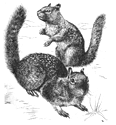Vertebrate Pest Conference: Proceedings

Vertebrate Pest Conference Proceedings: 7th (1976)
Date of this Version
March 1976
Document Type
Article
Abstract
Attempts to reduce blackbird numbers by spraying roosts have created considerable controversy. Opinions and suppositions fuel this controversy; yet, until now, decision makers have had no quantitative tools to predict the impacts of population reduction or to aid in formulating management strategies. To improve the predictive ability, we have synthesized data on red-winged blackbird (Agelaius phoeniceus) populations into a computerized system, BIRDS (Blackbird Information Retrieval and Data System). Grackles (Quiscalus quiscula), cowbirds (Molothrus ater), and starlings (Sturnus vulgaris) will be added to the system later. BIRDS is designed to estimate the number of redwings for any area of North America at the start of the nesting season, to simulate the annual cycle of numbers for the population, and to trace the general movements of the population. BIRDS, when complete, will give us the ability to estimate the immediate numerical effect on a population for any management operation involving lethal control. Two examples of hypothetical management strategies demonstrate the output generated by BIRDS and how this information can be used in making management decisions.

